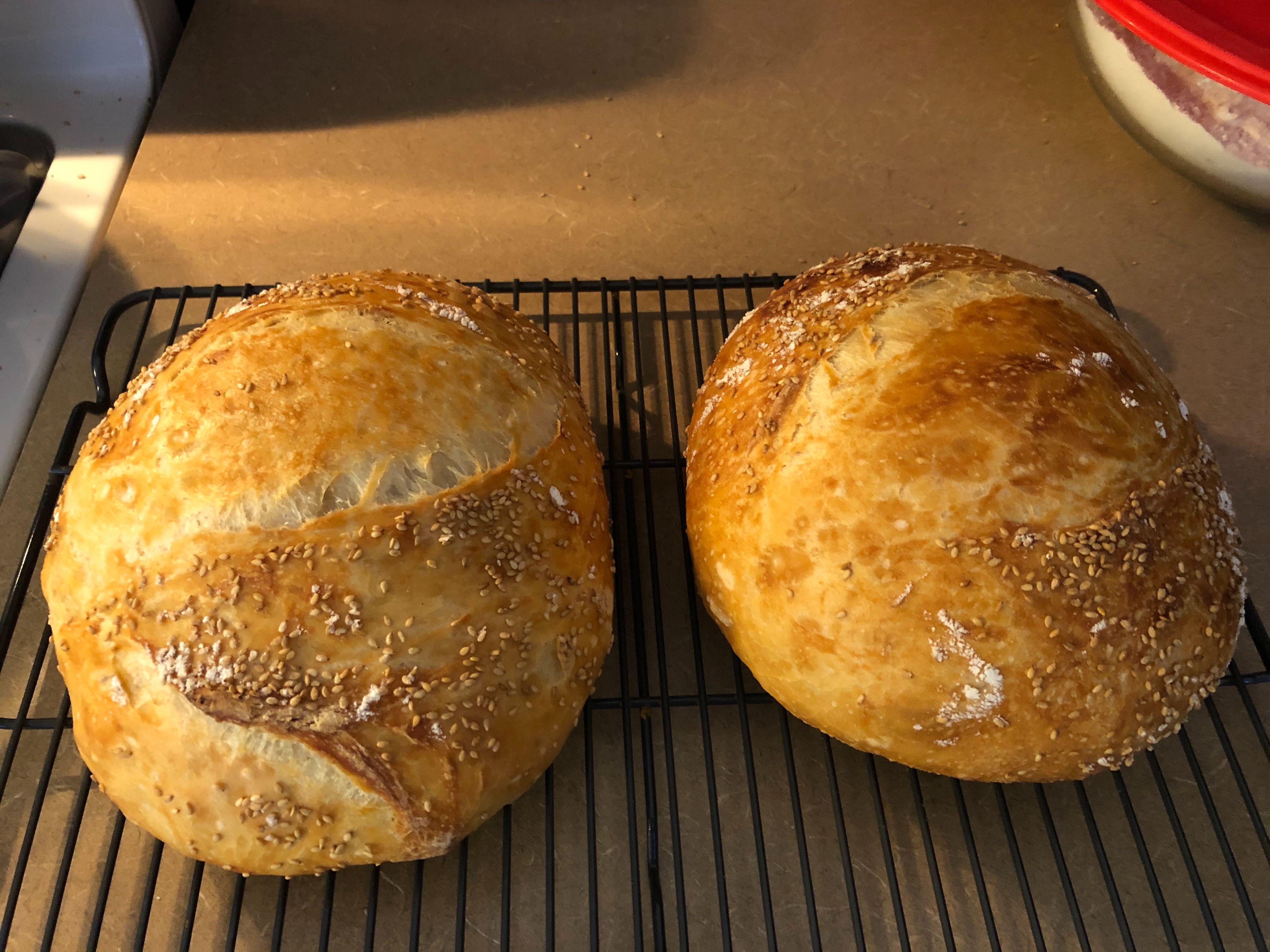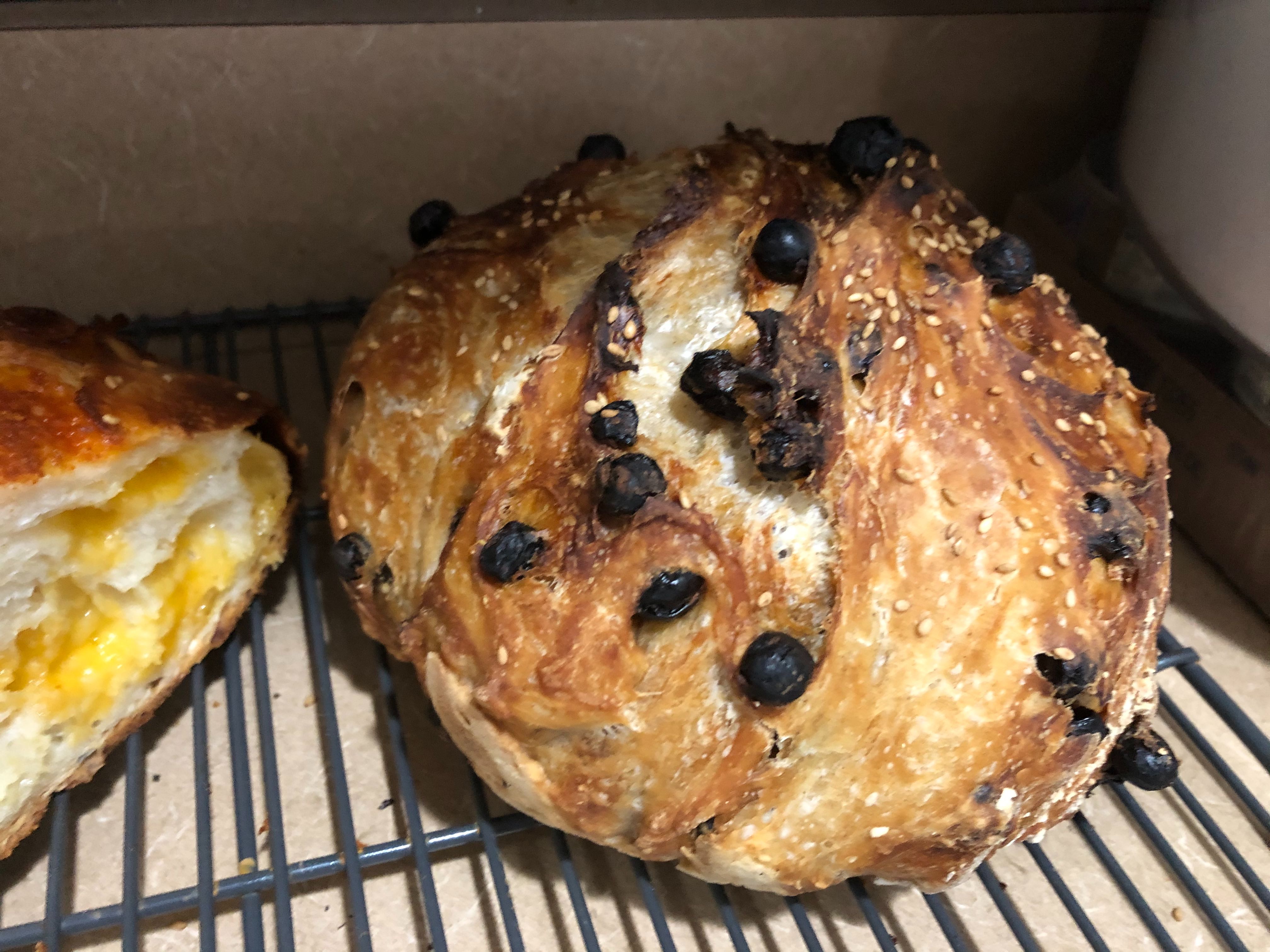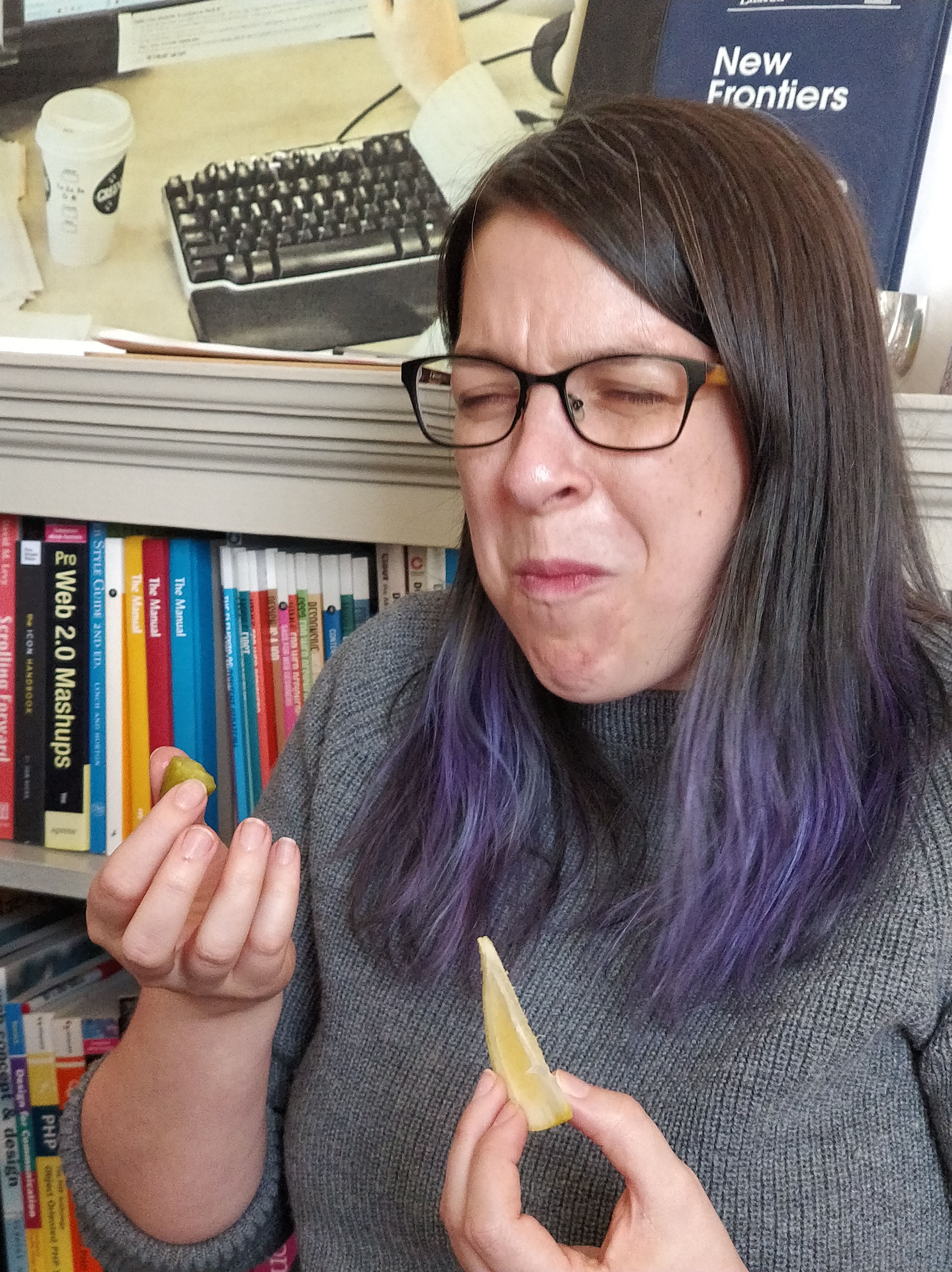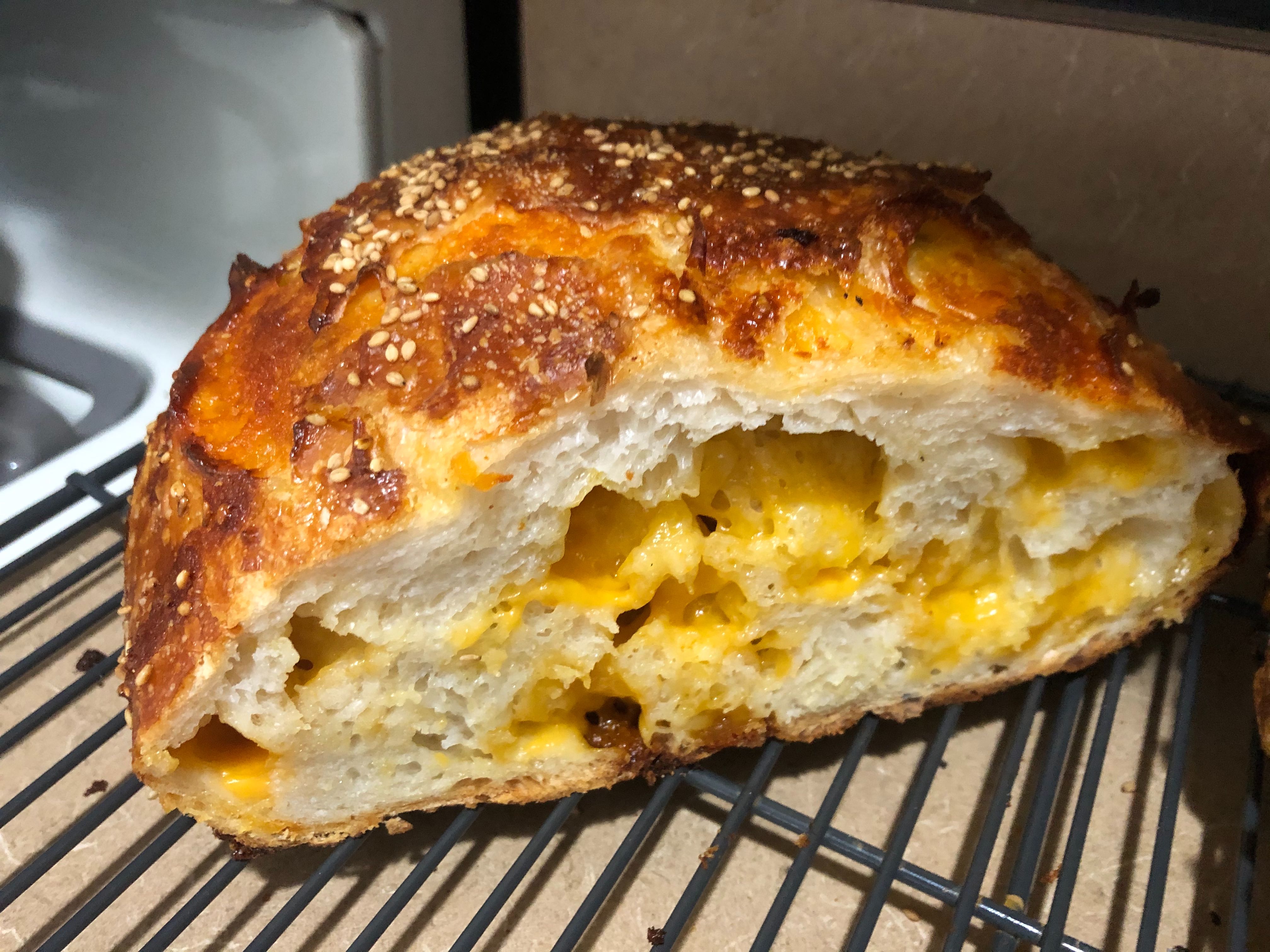A digital humanist can have a little bread, as a treat
This is a talky and unpolished post, and I think it’s good to sometimes share thinking in that format. I will try to… rise to the occasion.

I wasn’t sure about blogging a bread recipe here, but I figured since I’d already posted something substantial this month (co-authored with Jeremy Boggs: “Software licensing as feminist & queer digital humanities practice”) and was also tweeting frequently as part of the #GenerousThinking hashtag project (founded by Hannah Alpert-Abrams (@hralperta), Mimi Winick (@mimwinick), and Amanda Henrichs (@envynoveritas); based on Kathleen Fitzpatrick’s book of the same title), I could share something that’s less clearly scholarship.
Caveat emptor
But wait! I look at what I just wrote, and I’m reminded of how I’ve wanted to pay more attention to the impact of explanations and apologies of a certain kind, whether they’re undermining what I’m saying. If I think it’s okay to share some cooking info, shouldn’t I model that I think it’s okay for others to do that too, without having or offering any justification? The community-building piece of scholarship can include parts of ourselves that aren’t immediately connected to our research (noting, of course, that doing so isn’t safe or otherwise doable for everyone).

I’m going to keep that first paragraph up there because: this caveat is unclear, if I don’t include what I’m nuancing/objecting to. And I want to share the things in that paragraph, too: I’m proud of our software license focus, and sharing it has already resulted in getting a bunch of great feedback and research leads, especially from Ben Brumfield and Quinn Dombrowski. I love Kathleen’s book and Hannah, Mimi, and Amanda H.’s hashtag project—you should check both out! They’ve gotten me back into tweeting about things I’m thinking about, after a dry spell of mostly RTing/commenting on others’ tweets and not sharing so much of what I’m up to. I find doing so personally energizing and hope-making. I guess the point is I should still share that stuff, but in the future, do it in a way that isn’t making it an apology or an excuse to do something else I should just do without excuse (e.g. writing about bread). Keeping this thinking here commits me to that thinking a little more. (And it spurred me to draft several paragraphs of detailed thinking digressing on the topic of excuses, caveats, and quibbles, which I moved into a separate draft for a future post.)
Bread (and other food) for good
A very good bread recipe appears shortly down the page, but first I wanted to briefly share some connections between bread and the work of the lab. Caveat, the good kind: food is not an accessible presence/activity to everyone, so we do try to balance the good culture that can arise from sharing food with non-food stuff, and present food in a way that makes it avoidable without social awkwardness.
- During the final year of my PhD, I decided I needed a project unrelated to my research that would keep me off my computer, and figuring out how to make bread “with lots of holes in it” and a great crust became that project. The recipe below is an outcome that keeps on giving.
- One of the ways I started to get to know my colleagues, when I started this job, was by joining a SLab D&D group. My character was a Paladin of Baked Goods, and I had to make a lot of bread puns as part of the game. We’ve also had a series of “SLab Eats Weird Food”, where staff gather to try out things including: preserved pizza rations, pickled grapes, and Miraculin—which supposedly makes sour taste sweet, you take a pill and then eat lemon wedges etc. It Did Not Work for me:
 Photo courtesy Shane Lin.
Photo courtesy Shane Lin.
- SLab staff sometimes hold potluck lunches and invite student fellows or library staff colleagues we want to celebrate and thank (guests don’t need to bring food)
- We have a small kitchenette in the SLab staff offices, shared with other Library staff on the same floor. Groups of staff often end up getting a chance to see folks they wouldn’t otherwise, and to check in on how colleagues are doing, while waiting for the microwave or tasting food someone’s brought in to share.
- SLab 2023 (aka the shiny new Scholars’ Lab space after the Alderman Library renovation is completed) will have a larger kitchen area. We’ve been talking about ways to involve food in experimental research, e.g. a sourdough starter library and reading about historical breadbaking practices, using chocolates made from molds based on historic artifacts to engage people in discussions around 3D cultural heritage data).

Just the flax, please: Amanda’s bread
(Just the facts.)
Ingredients
(for one loaf of bread; I usually make 2 at a time, e.g. to make small changes and compare to the control loaf, and also because bread this good goes FAST)
- 3 cups all-purpose flour (I like King Arthur brand; I do not use bread flour, but once you’re comfortable with the recipe you can start experimenting with various flours and mix-ins like vital wheat gluten; baking one control loaf and one test loaf helps you compare and also always get at least one edible loaf out of an experiment)
- 0.25 tsp yeast (I use this kind; single-use yeast packets don’t have the right amount; I hear it’s good to replace the yeast you use once a year?)
- 1.5 tsp salt
- 1.5 cups room-temp water (no need to check with thermometer)
Nice to have:
- Sesame seeds (or other add-ins, e.g. raisins+cinnamon); SLab is currently going nuts over the Trader Joe’s Everything Bagel Seasoning Jeremy got me to use as a bread topping
- Tupperware container with lid. I like these because the high narrow shape makes it easy to mix without flour getting out of the bowl, and the width is okay to turn the container upside-down to cover the bread during its second rise right before putting in the oven. It’s helpful to use separate containers when simultaneously making two loaves of bread. But you just need something that will fit the dough as it expands, and protect it from air.
- 4 qt iron dutch oven with iron lid. (Metal that holds heat is critical in producing a good crust). A larger container is probably fine? But the pot and lid being iron or enameled iron are critical—don’t use a glass lid.
Prep the dough
- Start the dough 8-24 hours before you want to bake it (baking takes ~1.25 hours). 8-12 hours rising is probably optimal, so I usually make the dough before bed to bake the next morning, or mix in the morning and bake when I get home. If you let the dough rise for shorter or longer amounts, it will still be delicious but may have less height/holes/be more doughy.
- In whatever container you’ll let the dough rise in, mix the 3 dry ingredients together (flour, yeast, salt). I use a spatula to mix. If you’re making two loaves, I recommend putting each loaf in its own container so that you don’t need to rip the dough in half before baking (which messes with air pockets, structure).
- Add 1.5 cups of vaguely room temperature water (no need for thermometer) and stir until well blended with dry ingredients (if adding something that goes inside the bread like raisins, add these now; if adding something that goes only on the crust, such as sesame seeds, you’ll do this at a later point in the recipe instead). The result will be a lump.
- Cover from air and allow to rise for 8-24 hours (extended rising time and more moisture than other recipes makes up for not kneading the bread).
After 8-24 hours rising:
- Put the empty dutch oven (with lid on!) inside your oven, then preheat the oven to 450 degrees F. No need to grease the pot!
- Pick up all the dough from inside the container (I usually pick it up with one hand, and use my other hand to break the hold of parts of the dough that are stuck to the container walls). In this step, you want to interact briefly with the dough to shape it into a tight-ish ball that sits on the floured surface. We are not kneading! Don’t knead. We want to avoid breaking the air holes or bread structure that the rising created. I kind of take the dough in one hand, use the other hand to pull the other side of the dough slightly away from it (like 1-2 inches away from how it was), and then wrap/tuck the second hand’s dough under the first. This might sound confusing, but you’re just making the dough a bit more round-shaped and the surface tension tighter.
- Plop the dough on a surface and cover it from air, preferably with something that doesn’t touch the dough (e.g. not saran wrap; I like to set the dough on the tupperware lid, and turn the tupperware container used for the original mixing/rising upside down over the dough for this). You may wish to flour your hands and/or the surface you plop the dough onto, but I’ve gotten lazy and stopped doing that, and it’s fine—the dough sticks a bit to the surface, but not too badly.
3b. If desired, cover top of dough with sesame seeds or other toppings. - Set a timer for 30 minutes (the dough rests a bit, and the dutch oven gets preheated).
- Drop the dough into the dutch oven, replacing the lid on the dutch oven after. You really can just plop it in from like 6 inches above the pot—no need (knead! ha!) to get your hands close to the now hot metal of the pot.
- Replace lid on pot, put lidded pot containing dough into oven, bake 30 minutes.
- Remove dutch oven lid; bake 15 more minutes, remove from oven, remove bread from pot (put on a cooling rack if you have one—air flow underneath keeps that part of the crust crusty). Let cool 10-15 minutes before cutting.
Notes
- First I read this book to understand the ingredients in the bread, what’s happening during rising/baking, and how small changes to temperature, humidity, etc. change your bread (so I know how to refine to fit different house temps in summer vs. winter, or troubleshoot problems).
- I then adapted this popular NYTimes No-Knead bread recipe
- Thanks to fellow DH Amanda Amanda Licastro for reminding me Robin Sloan’s Sourdough: or, Lois and Her Adventures in the Underground Market is a good DHy novel about breadmaking and startup culture.
Bread! Hurray!
